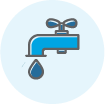Monarch Utilities Water Quality Report for Blue Mound Tx
Blue Mound
Contaminants Detected
7
EXCEED
EWG HEALTH
GUIDELINES
16 Total Contaminants
- Legal does not necessarily equal safe. Getting a passing grade from the federal government does not mean the water meets the latest health guidelines.
- Legal limits for contaminants in tap water have not been updated in almost 20 years.
- The best way to ensure clean tap water is to keep pollution out of source water in the first place.
Legal ≠ Safe
EWG Health Guidelines fill the gap in outdated government standards.
The federal government's legal limits are not health-protective. The EPA has not set a new tap water standard in almost 20 years, and some standards are more than 40 years old.
Contaminants Detected
Bromochloroacetic acid
Potential Effect: 8.3x EWG'S HEALTH GUIDELINE
THIS UTILITY 0.167 ppb
EWG HEALTH GUIDELINE 0.02 ppb
NO LEGAL LIMIT
DETAILS
X
Bromochloroacetic acid is formed when chlorine or other disinfectants are used to treat drinking water. Bromochloroacetic acid and other disinfection byproducts increase the risk of cancer and may cause problems during pregnancy.
Bromochloroacetic acid was found at 8.3 times above EWG's Health Guideline.
EWG Health Guideline
This Utility
National Average
State Average
The state and national averages were calculated using the averages of the contaminant measurements for each utility in 2017-2019.
ppb = parts per billion
Health Risks
The EWG Health Guideline of 0.02 ppb for bromochloroacetic acid was defined in a peer-reviewed scientific study by EWG and represents a on-in-a-million lifetime cancer risk level. This health guideline protects against cancer.
Pollution Sources

Treatment Byproducts
Filtering Options
![]()
Activated Carbon
![]()
Reverse Osmosis
Bromodichloromethane
Potential Effect: cancer 15x EWG'S HEALTH GUIDELINE
THIS UTILITY 0.925 ppb
EWG HEALTH GUIDELINE 0.06 ppb
NO LEGAL LIMIT
DETAILS
X
Bromodichloromethane, one of the total trihalomethanes (TTHMs), is formed when chlorine or other disinfectants are used to treat drinking water. Bromodichloromethane and other disinfection byproducts increase the risk of cancer and may cause problems during pregnancy. Click here to read more about disinfection byproducts.
Bromodichloromethane was found at 15 times above EWG's Health Guideline.
EWG Health Guideline
This Utility
National Average
State Average
The state and national averages were calculated using the averages of the contaminant measurements for each utility in 2017-2019.
ppb = parts per billion
Health Risks
The EWG Health Guideline of 0.06 ppb for bromodichloromethane was proposed in 2018 by the California Office of Environmental Health Hazard Assessment as a one-in-a-million lifetime risk of cancer. Values greater than one-in-a-million cancer risk level can result in increased cancer cases above one in a million people.
Pollution Sources

Treatment Byproducts
Filtering Options
![]()
Activated Carbon
![]()
Reverse Osmosis
Bromoform
Potential Effect: cancer 8.8x EWG'S HEALTH GUIDELINE
THIS UTILITY 4.39 ppb
EWG HEALTH GUIDELINE 0.5 ppb
NO LEGAL LIMIT
DETAILS
X
Bromoform, one of the total trihalomethanes (TTHMs), is formed when chlorine or other disinfectants are used to treat drinking water. Bromoform and other disinfection byproducts increase the risk of cancer and may cause problems during pregnancy. Click here to read more about disinfection byproducts.
Bromoform was found at 8.8 times above EWG's Health Guideline.
EWG Health Guideline
This Utility
National Average
State Average
The state and national averages were calculated using the averages of the contaminant measurements for each utility in 2017-2019.
ppb = parts per billion
Health Risks
The EWG Health Guideline of 0.5 ppb for bromoform was proposed in 2018 by the California Office of Environmental Health Hazard Assessment as a one-in-a-million lifetime risk of cancer. Values greater than one-in-a-million cancer risk level can result in increased cancer cases above one in a million people.
Pollution Sources

Treatment Byproducts
Filtering Options
![]()
Activated Carbon
![]()
Reverse Osmosis
Dibromoacetic acid
Potential Effect: 19x EWG'S HEALTH GUIDELINE
THIS UTILITY 0.750 ppb
EWG HEALTH GUIDELINE 0.04 ppb
NO LEGAL LIMIT
DETAILS
X
Dibromoacetic acid, one of the group of five haloacetic acids regulated by federal standards, is formed when chlorine or other disinfectants are used to treat drinking water. Haloacetic acids and other disinfection byproducts increase the risk of cancer and may cause problems during pregnancy. Click here to read more about disinfection byproducts.
Dibromoacetic acid was found at 19 times above EWG's Health Guideline.
EWG Health Guideline
This Utility
National Average
State Average
The state and national averages were calculated using the averages of the contaminant measurements for each utility in 2017-2019.
ppb = parts per billion
Health Risks
The EWG Health Guideline of 0.04 ppb for dibromoacetic acid was defined in a peer-reviewed scientific study by EWG and represents a on-in-a-million lifetime cancer risk level. This health guideline protects against cancer.
Pollution Sources

Treatment Byproducts
Filtering Options
![]()
Activated Carbon
![]()
Reverse Osmosis
Dibromochloromethane
Potential Effect: cancer 28x EWG'S HEALTH GUIDELINE
THIS UTILITY 2.80 ppb
EWG HEALTH GUIDELINE 0.1 ppb
NO LEGAL LIMIT
DETAILS
X
Dibromochloromethane, one of the total trihalomethanes (TTHMs), is formed when chlorine or other disinfectants are used to treat drinking water. Dibromochloromethane and other disinfection byproducts increase the risk of cancer and may cause problems during pregnancy. Click here to read more about disinfection byproducts.
Dibromochloromethane was found at 28 times above EWG's Health Guideline.
EWG Health Guideline
This Utility
National Average
State Average
The state and national averages were calculated using the averages of the contaminant measurements for each utility in 2017-2019.
ppb = parts per billion
Health Risks
The EWG Health Guideline of 0.1 ppb for dibromochloromethane was proposed in 2018 by the California Office of Environmental Health Hazard Assessment as a one-in-a-million lifetime risk of cancer. Values greater than one-in-a-million cancer risk level can result in increased cancer cases above one in a million people.
Pollution Sources

Treatment Byproducts
Filtering Options
![]()
Activated Carbon
![]()
Reverse Osmosis
Haloacetic acids (HAA5)†
Potential Effect: cancer 9.3x EWG'S HEALTH GUIDELINE
THIS UTILITY 0.933 ppb
EWG HEALTH GUIDELINE 0.1 ppb
LEGAL LIMIT 60 ppb
DETAILS
X
Haloacetic acids are formed when disinfectants such as chlorine are added to tap water. The group of five haloacetic acids regulated by federal standards includes monochloroacetic acid, dichloroacetic acid, trichloroacetic acid, monobromoacetic acid and dibromoacetic acid.
Haloacetic acids (HAA5) was found at 9.3 times above EWG's Health Guideline.
EWG Health Guideline
This Utility
Legal Limit
National Average
State Average
The state and national averages were calculated using the averages of the contaminant measurements for each utility in 2017-2019.
ppb = parts per billion
Health Risks
The EWG Health Guideline of 0.1 ppb for the group of five haloacetic acids, or HAA5, was defined in a peer-reviewed scientific study by EWG and represents a one-in-a-million lifetime cancer risk level. This health guideline protects against cancer.
Pollution Sources

Treatment Byproducts
Filtering Options
![]()
Activated Carbon
![]()
Reverse Osmosis
Total trihalomethanes (TTHMs)†
Potential Effect: cancer 88x EWG'S HEALTH GUIDELINE
THIS UTILITY 13.2 ppb
EWG HEALTH GUIDELINE 0.15 ppb
LEGAL LIMIT 80 ppb
DETAILS
X
Trihalomethanes are cancer-causing contaminants that form during water treatment with chlorine and other disinfectants. The total trihalomethanes group includes four chemicals: chloroform, bromodichloromethane, dibromochloromethane and bromoform.
Total trihalomethanes (TTHMs) was found at 88 times above EWG's Health Guideline.
EWG Health Guideline
This Utility
Legal Limit
National Average
State Average
The state and national averages were calculated using the averages of the contaminant measurements for each utility in 2017-2019.
ppb = parts per billion
Health Risks
The health guideline of 0.15 parts per billion, or ppb, for the group of four trihalomethanes, or THM4/TTHM, was defined in a peer-reviewed scientific study by EWG and represents a one-in-one-million lifetime cancer risk level.
Pollution Sources

Treatment Byproducts
Filtering Options
![]()
Activated Carbon
![]()
Reverse Osmosis
Includes chemicals detected in 2017-2019 for which annual utility averages exceeded an EWG-selected health guideline established by a federal or state public health authority.
† HAA5 is a contaminant group that includes monochloroacetic acid, dichloroacetic acid, trichloroacetic acid, monobromoacetic acid and dibromoacetic acid. HAA9 is a contaminant group that includes the chemicals in HAA5 and bromochloroacetic acid, bromodichloroacetic acid, chlorodibromoacetic acid and tribromoacetic acid. TTHM is a contaminant group that includes bromodichloromethane, bromoform, chloroform and dibromochloromethane.
Aluminum
THIS UTILITY 6.25 ppb
EWG HEALTH GUIDELINE 600 ppb
NO LEGAL LIMIT
DETAILS
X
Aluminum is a metal released from metal refineries and mining operations. Too much aluminum exposure can impair children's brain development.
How your levels compare
EWG Health Guideline
This Utility
National Average
State Average
The state and national averages were calculated using the averages of the contaminant measurements for each utility in 2017-2019.
ppb = parts per billion
Health Risks
The EWG Health Guideline of 600 ppb for aluminum was defined by the California Office of Environmental Health Hazard Assessment as a public health goal, the level of a drinking water contaminant that does not pose a significant health risk. This health guideline protects against harm to the brain and nervous system.
Pollution Sources

Industry

Naturally Occurring
Filtering Options
![]()
Reverse Osmosis
Barium
THIS UTILITY 12.8 ppb
EWG HEALTH GUIDELINE 700 ppb
LEGAL LIMIT 2,000 ppb
DETAILS
X
Barium is a mineral present in rocks, soil and water. High concentrations of barium in drinking water increase the risk of cardiovascular disease and hypertension.
How your levels compare
EWG Health Guideline
This Utility
Legal Limit
National Average
State Average
The state and national averages were calculated using the averages of the contaminant measurements for each utility in 2017-2019.
ppb = parts per billion
Health Risks
The EWG Health Guideline of 700 ppb for barium was defined by EWG as benchmark that protects against harm to the kidneys and the cardiovascular system.
Pollution Sources

Industry

Naturally Occurring
Filtering Options
![]()
Reverse Osmosis
![]()
Ion Exchange
Chromium (total)
THIS UTILITY 1.45 ppb
NO EWG HEALTH GUIDELINE
LEGAL LIMIT 100 ppb
DETAILS
X
Chromium is a naturally occurring metal, but industrial uses can elevate its levels in water. One form, hexavalent chromium, causes cancer. Total chromium is not a good indicator of the amount of hexavalent chromium in drinking water.
How your levels compare
This Utility
Legal Limit
National Average
State Average
The state and national averages were calculated using the averages of the contaminant measurements for each utility in 2017-2019.
ppb = parts per billion
Pollution Sources

Industry

Naturally Occurring
Filtering Options
![]()
Reverse Osmosis
![]()
Ion Exchange
Fluoride
THIS UTILITY 1.42 ppm
NO EWG HEALTH GUIDELINE
LEGAL LIMIT 4 ppm
DETAILS
X
Fluoride occurs naturally in surface and groundwater and is also added to drinking water by many water systems.
How your levels compare
This Utility
Legal Limit
National Average
State Average
The state and national averages were calculated using the averages of the contaminant measurements for each utility in 2017-2019.
ppm = parts per million
Pollution Sources

Treatment Byproducts
Filtering Options
![]()
Reverse Osmosis
Manganese
THIS UTILITY 1.13 ppb
EWG HEALTH GUIDELINE 100 ppb
NO LEGAL LIMIT
DETAILS
X
Manganese is a naturally occurring element that is common in food and drinking water. Excessive manganese exposures may impair children's attention, memory and intellectual capacity. Click here to read more about manganese.
How your levels compare
EWG Health Guideline
This Utility
National Average
State Average
The state and national averages were calculated using the averages of the contaminant measurements for each utility in 2017-2019.
ppb = parts per billion
Health Risks
The EWG Health Guideline of 100 ppb for manganese was defined by the state of Minnesota as a health risk limit, the concentration of a contaminant that can be consumed with little or no risk to health. This health guideline protects against harm to the brain and nervous system.
Pollution Sources

Industry

Naturally Occurring
Filtering Options
![]()
Ion Exchange
Methyl ethyl ketone
THIS UTILITY 0.335 ppb
NO EWG HEALTH GUIDELINE
NO LEGAL LIMIT
DETAILS
X
Methyl ethyl ketone is a volatile solvent used in paints, adhesives, and other industrial and consumer goods.
How your levels compare
This Utility
National Average
State Average
The state and national averages were calculated using the averages of the contaminant measurements for each utility in 2017-2019.
ppb = parts per billion
Pollution Sources

Industry

Runoff & Sprawl
Filtering Options
![]()
Activated Carbon
![]()
Reverse Osmosis
Monochloroacetic acid
THIS UTILITY 0.183 ppb
EWG HEALTH GUIDELINE 53 ppb
NO LEGAL LIMIT
DETAILS
X
Monochloroacetic acid, one of the group of five haloacetic acids regulated by federal standards, is formed when chlorine or other disinfectants are used to treat drinking water. Haloacetic acids and other disinfection byproducts increase the risk of cancer and may cause problems during pregnancy. Click here to read more about disinfection byproducts.
How your levels compare
EWG Health Guideline
This Utility
National Average
State Average
The state and national averages were calculated using the averages of the contaminant measurements for each utility in 2017-2019.
ppb = parts per billion
Health Risks
The EWG Health Guideline of 53 ppb for monochloroacetic acid was proposed in 2020 by the California Office of Environmental Health Hazard Assessment as a public health goal, the level of a drinking water contaminant that does not pose a significant health risk.. This health guideline protects against system toxicity.
Pollution Sources

Treatment Byproducts
Filtering Options
![]()
Activated Carbon
![]()
Reverse Osmosis
Nitrate
THIS UTILITY 0.0814 ppm
EWG HEALTH GUIDELINE 0.14 ppm
LEGAL LIMIT 10 ppm
DETAILS
X
Nitrate, a fertilizer chemical, frequently contaminates drinking water due to agricultural and urban runoff, and discharges from municipal wastewater treatment plants and septic tanks. Excessive nitrate in water can cause oxygen deprivation in infants and increase the risk of cancer. Click here to read more about nitrate.
How your levels compare
EWG Health Guideline
This Utility
Legal Limit
National Average
State Average
The state and national averages were calculated using the averages of the contaminant measurements for each utility in 2017-2019.
ppm = parts per million
Health Risks
The EWG Health Guideline of 0.14 ppm for nitrate was defined by EWG . This health guideline protects against cancer and harm to fetal growth and development.
Pollution Sources

Agriculture

Runoff & Sprawl

Naturally Occurring
Filtering Options
![]()
Reverse Osmosis
![]()
Ion Exchange
Nitrate and nitrite
THIS UTILITY 0.175 ppm
EWG HEALTH GUIDELINE 0.14 ppm
LEGAL LIMIT 10 ppm
DETAILS
X
Nitrate and nitrite enter water from fertilizer runoff, septic tanks and urban runoff. These contaminants can cause oxygen deprivation for infants and increase the risk of cancer. Nitrite is significantly more toxic than nitrate. Click here to read more about nitrate.
How your levels compare
EWG Health Guideline
This Utility
Legal Limit
National Average
State Average
The state and national averages were calculated using the averages of the contaminant measurements for each utility in 2017-2019.
ppm = parts per million
Health Risks
The health guideline of 0.14 parts per million, or ppm, for nitrate and nitrite is based on the equivalent health guideline for nitrate, as defined in a peer-reviewed scientific study by EWG. This guideline represents a one-in-one-million annual cancer risk level.
Pollution Sources

Agriculture

Runoff & Sprawl

Naturally Occurring
Filtering Options
![]()
Reverse Osmosis
![]()
Ion Exchange
Includes chemicals detected in 2017-2019 for which annual utility averages were lower than an EWG-selected health guideline established by a federal or state public health authori.
Other Contaminants Tested
✕
Blue Mound compliance with legally mandated federal standards:
- From April 2019 to March 2021, Blue Mound complied with health-based drinking water standards.
-
1 QUARTER
in violation of any federal drinking water standard from April 2019 to March 2021
Information in this section on Blue Mound comes from the U.S. EPA Enforcement and Compliance History Online database (ECHO).
LEARN MORE ABOUT THIS UTILITY
Water Filters That Can Reduce Contaminant Levels
| Contaminant | Activated Carbon | Reverse Osmosis | Ion Exchange |
| CONTAMINANTS ABOVE HEALTH GUIDELINES | |||
| Bromochloroacetic acid | ✔ | ✔ | |
| Bromodichloromethane | ✔ | ✔ | |
| Bromoform | ✔ | ✔ | |
| Dibromoacetic acid | ✔ | ✔ | |
| Dibromochloromethane | ✔ | ✔ | |
| Haloacetic acids (HAA5) | ✔ | ✔ | |
| Total trihalomethanes (TTHMs) | ✔ | ✔ | |
| OTHER CONTAMINANTS DETECTED | |||
| Aluminum | ✔ | ||
| Barium | ✔ | ✔ | |
| Chromium (total) | ✔ | ✔ | |
| Fluoride | ✔ | ||
| Manganese | ✔ | ||
| Methyl ethyl ketone | ✔ | ✔ | |
| Monochloroacetic acid | ✔ | ✔ | |
| Nitrate | ✔ | ✔ | |
| Nitrate & nitrite | ✔ | ✔ | |
Take Action
Contact Your Local Official
One of the best ways to push for cleaner water is to hold accountable the elected officials who have a say in water quality – from city hall and the state legislature to Congress all the way to the Oval Office – by asking questions and demanding answers.
LEARN MORE
Filter Out Contaminants
Check out our recommendations for filters to protect your water against the detected contaminants.
EWG'S WATER FILTER GUIDE
Source: https://www.ewg.org/tapwater/system.php?pws=TX2200005

0 Response to "Monarch Utilities Water Quality Report for Blue Mound Tx"
Post a Comment